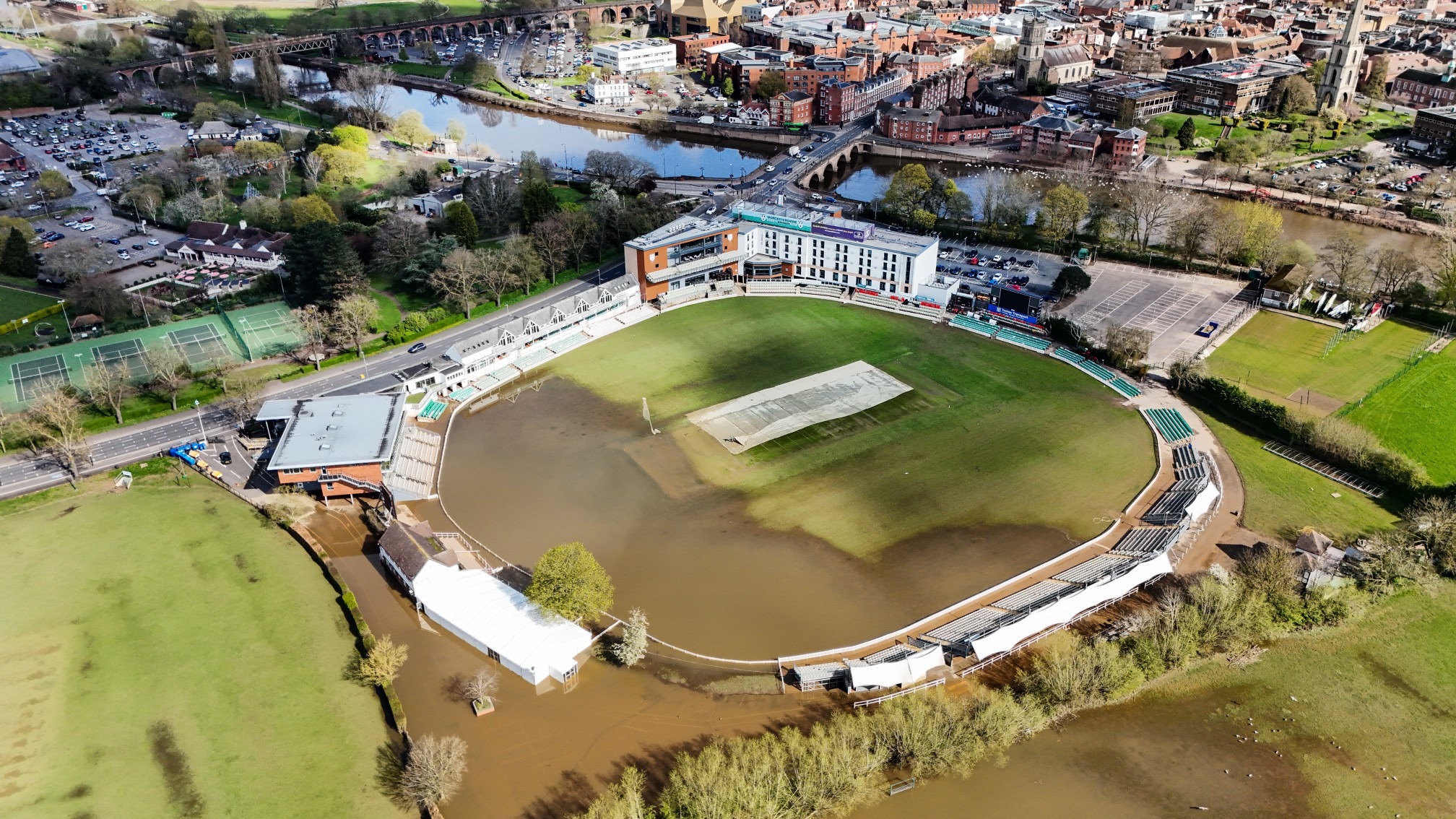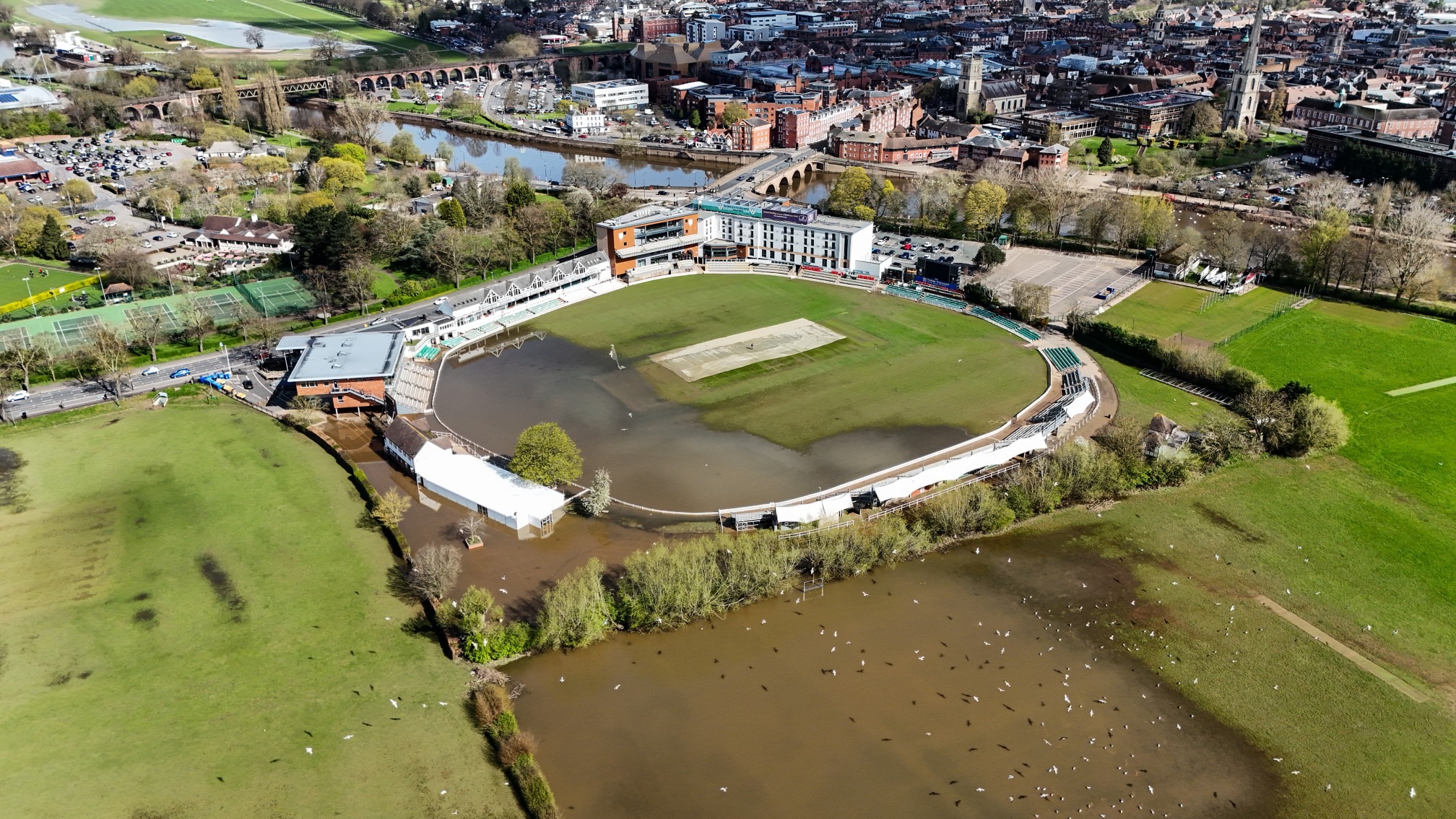Iconic Venue Underwater
Worcestershire's famous cricket ground, New Road, has been engulfed in water just days before the start of the new season.
The flooding has caused significant damage to one side of the ground and surrounding fields.
History of Flooding
New Road, located on the west bank of the River Severn, is no stranger to flooding, especially during the winter months.
In January, flash floods left the venue completely underwater, and a match in 2019 had to be relocated due to flooding.

Impact on New Season
The timing of this latest flooding is concerning as the County Championship is set to begin soon.
Worcestershire's first home match on April 19 will be held at Chester Road North in Kidderminster instead of New Road.
Looking Ahead
Despite the challenges, Worcestershire is gearing up for their return to division one after winning promotion last season.
The team will split their home matches between Chester Road North and the historic New Road, which has been their home since 1897.

Frequently Asked Questions
Do professional cricketers have specific recovery protocols they follow after a match or training?
Cricketers who are professional follow specific recovery protocols to ensure that they remain in top physical condition. These protocols include stretching sessions, cooldown exercises to relieve muscle tension and cryotherapy or ice baths to reduce muscle soreness and inflammation. Proper nutrition and hydration play a vital role in recovery, with an emphasis on protein intake for muscle repair. The importance of adequate sleep and physiotherapy is also stressed. This may include massages, foam rollers, and injury-specific rehabilitation exercises. Such comprehensive recovery regimens are essential to manage workload and prevent injuries.
How often does a professional cricketer train?
The schedules of professional cricketers are intense during the series and tournaments, as well as in the run-up to the season. They train five to six days per week for most of the year. They focus on different aspects of their game including physical fitness and skills training. In the offseason, players may train less frequently or with less intensity. This allows them to rest and improve their skills or address specific areas of play.
How do professional Cricketers train when the weather is bad?
Cricketers adjust their training schedules to suit the weather. Indoor facilities provide an alternative to outdoor nets for practicing batting and bowling. These facilities include gym equipment, indoor running track and other strength and fitness training tools. When outdoor training is not possible, alternative cardio exercises such as swimming or other aquatic activities can be used to keep fit. The teams and coaches are able to modify training plans in order to maintain consistency regardless of weather.
Do cricketers specialize in one skill, or do they train in all areas of the game?
Cricketers may have a primary skill such as batting or bowling. They are also trained in other areas to make them more versatile and adaptable. Even bowlers and batsmen who are specialists dedicate time to developing their fielding skills. All-rounders – who play both batting as well as bowling – split their training hours to improve on both skill sets. Training in all facets of the game is essential for team balance, and it provides greater strategic options for the team’s composition.
What is the normal training schedule for a professional cricketer?
The training program of a professional cricketer is structured and rigorous. It focuses on developing physical fitness, technical skills, and game strategies. Morning fitness sessions are usually devoted to cardiovascular exercises, agility drills, and strength training. Afternoons are typically reserved for skill-specific training, such as batting, bowling, and fielding practices. Cricketers also practice simulated matches to prepare them for the real game, as well as regular net sessions. Rest and recuperation are also important parts of the cricket schedule. Particular attention is given to adequate sleep, and physiotherapy where needed.
Statistics
- A typical professional cricketer may spend up to 12-15% of their training time on mental skills, such as visualization and cognitive exercises.
- Professional cricketers playing at the international level may engage in upward of 200 hours of net practice sessions in a year.
- High-intensity interval training (HIIT) sessions, which are regularly included in cricketers’ fitness regimes, can increase their oxygen consumption by approximately 5-10%.
- Dietary analysis of elite cricketers reveals that they consume approximately 55-60% of their daily calories from carbohydrates during intense training periods.
- Spin bowlers spend an estimated 50-60% more time honing their technique in the nets compared to fast bowlers, who focus more on physical conditioning.
External Links
pitchvision.com
prodirectcricket.com
wisden.com
espncricinfo.com
cricket.com.au
How To
How To Utilize Sports Technology in Cricket Training
Sports technology has the potential to improve cricket training. Use tools such as ball tracking or pitch mapping to analyze a player’s delivery, and a hitter’s shot choice. Integrate wearables that monitor the athletes’ heart rates, physical activity, and movement patterns. Harness video analysis software to review techniques and tactics, enabling players to make data-driven improvements to their game. To maximize this technology’s potential, players and coaches must be properly trained. This will allow for more individualized and focused training programs.

